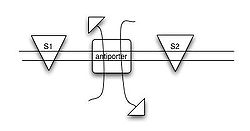
Antiporter
Encyclopedia

Integral membrane protein
An integral membrane protein is a protein molecule that is permanently attached to the biological membrane. Proteins that cross the membrane are surrounded by "annular" lipids, which are defined as lipids that are in direct contact with a membrane protein...
involved in secondary active transport
Secondary active transport
In secondary active transport or co-transport, uses energy to transport molecules across a membrane; however, in contrast to primary active transport, there is no direct coupling of ATP; instead, the electrochemical potential difference created by pumping ions out of the cell is used...
of two or more different molecules or ions (i.e., solutes) across a phospholipid membrane such as the plasma membrane in opposite directions.
In secondary active transport
Secondary active transport
In secondary active transport or co-transport, uses energy to transport molecules across a membrane; however, in contrast to primary active transport, there is no direct coupling of ATP; instead, the electrochemical potential difference created by pumping ions out of the cell is used...
, one species of solute moves along its electrochemical gradient, allowing a different species to move against its own electrochemical gradient. This movement is in contrast to primary active transport
Primary active transport
Primary active transport, also called direct active transport, directly uses energy to transport molecules across a membrane.Most of the enzymes that perform this type of active transport are transmembrane ATPases. A primary ATPase universal to all cellular life is the sodium-potassium pump, which...
, in which all solutes are moved against their concentration gradients, fueled by ATP
Adenosine triphosphate
Adenosine-5'-triphosphate is a multifunctional nucleoside triphosphate used in cells as a coenzyme. It is often called the "molecular unit of currency" of intracellular energy transfer. ATP transports chemical energy within cells for metabolism...
.
Transport may involve one or more of each type of solute. For example, the Na+/Ca2+ exchanger
Sodium-calcium exchanger
The sodium-calcium exchanger is an antiporter membrane protein that removes calcium from cells. It uses the energy that is stored in the electrochemical gradient of sodium by allowing Na+ to flow down its gradient across the plasma membrane in exchange for the countertransport of calcium ions...
, used by many cells to remove cytoplasmic calcium, exchanges one calcium ion for three sodium ions.
See also
- UniporterUniporterA uniporter is an integral membrane protein that is involved in facilitated diffusion. They can be either a channel or a carrier protein....
- SymporterSymporterA cotransporter is an integral membrane protein that is involved in secondary active transport. It works by binding to two molecules or ions at a time and using the gradient of one solute's concentration to force the other molecule or ion against its gradient....
- Sodium-calcium exchangerSodium-calcium exchangerThe sodium-calcium exchanger is an antiporter membrane protein that removes calcium from cells. It uses the energy that is stored in the electrochemical gradient of sodium by allowing Na+ to flow down its gradient across the plasma membrane in exchange for the countertransport of calcium ions...
- Facilitated diffusionFacilitated diffusion..Facilitated diffusion is a process of passive transport, facilitated by integral proteins. Facilitated diffusion is the spontaneous passage of molecules or ions across a biological membrane passing through specific transmembrane integral proteins...
- Sodium/proton antiporter 1Sodium/proton antiporter 1Na+/H+ antiporter 1 family contains a number of bacterial Na+/H+ antiporter 1 proteins. These are integral membrane proteins that catalyse the exchange of H+ for Na+ in a manner that is highly dependent on the pH....

